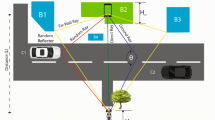Abstract
The goal of the article is to provide a radio propagation algorithm for an outdoor-to-indoor and indoor-to-indoor environment for 5G mmWave in a populated city. This work is done by simulating a smart 3D ray tracing algorithm in MATLAB. The research here is done by taking into account the 28 [GHz] operating frequency which is potential for 5G network. The received results are provided in form of path loss and received signal strength. The results obtained show that a moderate outdoor-to-indoor service can be provided at the above-mentioned frequency. Two indoor path loss models (WINNER II and ITU-R) are also compared here. The literature review provided here is sufficient enough to prove that there is still a huge gap between the conventional ray tracing methods. The proposed model here deals with radio propagations using speedy computations and efficient use of resources. The findings of this paper also include that the path loss is also dependent on the separation between transmitter and receiver, the structure of the building and number and type of the obstructions in the path of RF waves.





















Similar content being viewed by others
References
Ever, E.; Al-Turjman, F.; Zahmatkesh, H.; Riza, M.: Modelling green HetNets in dynamic ultra large-scale applications. Comput. Netw. Int. J. Comput. Telecommun. Netw. 128, 78–93 (2017)
Kiran, J.; Nimavat, D.: Comparative analysis of path loss propagation models in radio communication. In: IJIRCCE, vol. 3, no. 2 (2015). http://www.ijircce.com/upload/2015/february/62_COMPARATIVE.pdf
5G; Study on channel model for frequencies from 0.5 to 100 GHz (3GPP TR 38.901 version 15.0.0 Release 15)
Vuokko, N.; et al.: Deliverable D1.2: initial channel models based on measurements (2014). https://metis2020.com/wp-content/uploads/deliverables/METIS_D1.2_v1.pdf. Accessed 13 Jan 2020
International Telecommunication Union: Guidelines for evaluation of radio interface technologies for IMT-2020, Geneva, Switzerland Rec. ITU-R M.2135-1, December (2017)
Rappaport, T.S.; Heath, R.W.; Daniels, R.C.; Murdock, J.N.: Millimeter Wave Wireless Communications. Prentice Hall, Upper Saddle River (2015)
Pahlavan, K.; Levesque, A.H.: Wireless Information Networks. Wiley Series in Telecommunications and Signal Processing, 2nd edn, pp. 245–261. Wiley, Hoboken (2005). (John Proakis, Series Editor)
Seidel, S.Y.; Rappaport, T.S.: Site-specific propagation prediction for wireless in-building personal communication system design. IEEE Trans. Veh. Technol. 43(4), 879–891 (1994)
Trueman, C. W.; Paknys, R.; Zhao, J.; Davis, D.; Segal, B.: Ray tracing algorithm for indoor propagation. In: ACES 16th Annual Review of Progress in Applied Computational Electromagnetics, Monterey, California, pp. 493-500, March 20–24 (2000)
Mishra, A.R.: Advanced Cellular Network Planning and Optimization 2G/2.5G/3G, Evolution to 4G. Wiley, New York (2007)
Bregar, K.; et al.: Evaluation of range-based indoor tracking algorithms by merging simulation and measurements. EURASIP J. Wirel. Commun. Netw. 2019, 173 (2019)
Hossain, F.; et al.: A smart 3D RT method: indoor radio wave propagation modelling at 28 GHz. Symmetry 11(4), 510 (2019)
Maccartney, G.R.; Rappaport, T.S.; Sun, S.; Deng, S.: Indoor office wideband millimeter-wave propagation measurements and channel models at 28 and 73 GHz for ultra-dense 5G wireless networks. IEEE Access 3, 2388–2424 (2015)
MacCartney, G.R.; Rappaport, T.S.; Samimi, M.K.; Sun, S.: Millimeter-wave omnidirectional path loss data for small cell 5G channel modeling. IEEE Access 3, 1573–1580 (2015)
Samimi, M.K.; Rappaport, T.S.; MacCartney, G.R.: Probabilistic omnidirectional path loss models for millimeter-wave outdoor communications. IEEE Wirel. Commun. Lett. 4, 357–360 (2015)
Sulyman, A.I.; Nassar, A.T.; Samimi, M.K.; MacCartney, G.R.; Rappaport, T.S.; Alsanie, A.: Radio propagation path loss models for 5G cellular networks in the 28 GHz and 38 GHz millimeter-wave bands. IEEE Commun. Mag. 52, 78–86 (2014)
Larsson, C.; Olsson, B.-E.; Medbo, J.: Angular resolved pathloss measurements in urban macrocell scenarios at 28 GHz. In: Proceedings of the 2016 IEEE 84th Vehicular Technology Conference (VTC-Fall), Montreal, QC, Canada, 18–21 September 2016, pp. 1–5
Huang, J.; Wang, C.-X.; Feng, R.; Sun, J.; Zhang, W.; Yang, Y.: Multi-frequency mmWave massive MIMO channel measurements and characterization for 5G wireless communication systems. IEEE J. Sel. Areas Commun. 35, 1591–1605 (2017)
Sidhu, S.S.; Khosla, A.; Sharma, A.: Implementation of 3-D ray tracing propagation model for indoor wireless communication. Int. J. Electron. Eng. 4(1), 43–47 (2012)
Samimi, M.; Rappaport, T.S.: 3-D millimeter-wave statistical channel model for 5G wireless system design. IEEE Trans. Microw. Theory Tech. 64(7), 1–19 (2016). https://doi.org/10.1109/TMTT.2016.2574851
Anna, D.; et al.: Measurement-based coverage function for green femtocell networks. Comput. Netw. 83, 45–58 (2015)
Enterprise Multi-Femtocell Deployment Guidelines. Incorporate qualcomm 2011. https://www.qualcomm.com/media/documents/files/qualcomm-research-enterprise-femtocell.pdf
Sheikh, M.U.; Hiltunen, K.; Lempiainen, J.: Enhanced outdoor to indoor propagation models and impact of different ray tracing approaches at higher frequencies. Adv. Sci. Technol. Eng. Syst. J. 3(2), 58–68 (2018)
Majdi, S.; et al.: Validation of three-dimensional ray-tracing algorithm for indoor wireless propagations. ISRN Commun. Netw. Article ID 324758. http://downloads.hindawi.com/archive/2011/324758.pdf (2011)
Author information
Authors and Affiliations
Corresponding author
Rights and permissions
About this article
Cite this article
Ullah, U., Kamboh, U.R., Hossain, F. et al. Outdoor-to-Indoor and Indoor-to-Indoor Propagation Path Loss Modeling Using Smart 3D Ray Tracing Algorithm at 28 GHz mmWave. Arab J Sci Eng 45, 10223–10232 (2020). https://doi.org/10.1007/s13369-020-04661-w
Received:
Accepted:
Published:
Issue Date:
DOI: https://doi.org/10.1007/s13369-020-04661-w




